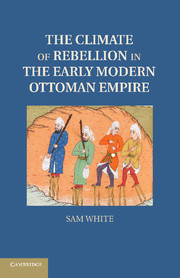Conclusion
Published online by Cambridge University Press: 05 February 2012
Summary
This book has offered a new interpretation of Ottoman history from the sixteenth to the eighteenth centuries. It has argued that in order to understand the empire's successes, crises, and transformations, historians must take into account the ecological conditions of the early modern Near East and the profound impacts and repercussions of the Little Ice Age. In Part I, this study made the case for an expansive “imperial ecology” that underlay the empire's rapid expansion in the classical age but which became increasingly vulnerable to war and natural disaster as population pressure set in over the late 1500s. Part II examined the impact of Little Ice Age climatic fluctuations from the late sixteenth through the early eighteenth centuries, demonstrating the strong links between extreme climate events and the outbreak of the Celali Rebellion and the recurring disorders of the 1600s. Finally, Part III made the case that transformations in human ecology – particularly the spread of nomadic pastoralism, migration to urban areas, and a shift to new crops for commerce and exports – slowed the demographic recovery of Ottoman lands, leaving the empire relatively depopulated by the mid-nineteenth century.
- Type
- Chapter
- Information
- The Climate of Rebellion in the Early Modern Ottoman Empire , pp. 298 - 300Publisher: Cambridge University PressPrint publication year: 2011

